Posted by Elena del Valle on September 1, 2012

I’ll Have What She’s Having book cover
Photo: The MIT Press
In what ways does social learning shape human behavior? In other words, does what a friend or acquaintance think or say affect what someone does? If the well known scene of the movie When Harry Met Sally where Sally, while having lunch with Harry at a deli, fakes an orgasm in a loud way audible to her neighbors prompting one of the patrons of the deli to order “what she is having” from the waiter is to be believed social behavior is clearly impacted by the behavior of others.
Alex Bentley, Mark Earls and Michael J. O’Brien believe that social learning affect social behavior in a variety of ways, expending from an individual outward to a community and population. In I’ll Have What She’s Having Mapping Social Behavior (The MIT Press, $22.95), a book with an an academic tone published last year, they describe their ideas about social learning and its impact on society. They believe that many people are lazy, relying on others to think and store knowledge.
The book, they say in the Preface, is meant to provide a human behavior map to readers. According to the authors, people are “beset with emotions and cognitive biases, and much of the time we avoid thinking altogether” instead of the calculating and rational beings some like to believe they are. The social nature of evolution and behavior affects culture, especially among masses of people in modern times, they say.
Social learning drives the spread of culture and human behavior and diffuses innovations, according to the authors. To understand the learning patterns they identified three models: diffusion, cascades and undirected copying. The 146-page hardcover book is divided into seven chapters: Out of the Trees; Rules of the Game; Copying Brain, Social Mind; Social Learning en Masse; Cascades; When in Doubt, Copy; and Mapping Collective behavior.
Bentley is professor of anthropology and archeology at the University of Bristol, United Kingdom. Earls is a London-based author and marketing consultant. O’Brien, dean, College of Arts and Science, professor of anthropology and director of the Museum of Anthropology at the University of Missouri.

Click to buy I’ll Have What She’s Having
Comments:
Filed Under: Books
Posted by Elena del Valle on August 24, 2012
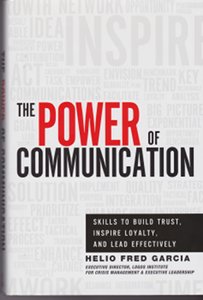
The Power of Communication book cover
Photo Helio Fred Garcia: Newman Communications
To be successful leaders must posses outstanding communication skills. That is the firm belief of Helio Fred Garcia, executive director, Logos Institute for Crisis Management and Executive Leadership. To master the skill of effective communication a leader must reach his or her audience where they are, he says.
In The Power of Communication: Skills to Build Trust, Inspire Loyalty, and Lead Effectively (FT Press, $26), published this year, he explains his thinking. He relies in part for his theories on Warfighting, the Marine Corps strategy doctrine military manual.
Communication has power that must be harnessed to keep it from backfiring, he says at the beginning of the book. At the same time, he believes that many of the principles necessary to lead armed forces are applicable to the discipline of public communication.
His goal in writing the book was to convert the Warfighting ideas into guidelines leaders can rely on for effective communication; share best practices lessons he has learned over his extensive years as a leadership consultant; and outline prominent case studies of communication failures and successes. Among the failures he cites Tony Hayward’s ineffectual handling of the 2010 BP Gulf of Mexico oil rig disaster and spill. He closes, in Chapter 10, with Nine Principles of Effective Leadership Communication.

Helio Fred Garcia, author, The Power of Communication
“Age by itself is not necessarily an issue, but generational temperament is. One of the core principles (Principle No. 2) is that if we are to move people, we need to meet them where they are. That includes knowing what they care about, knowing how they prefer to be engaged, and even knowing what their capacity is for engagement,” Garcia said by email in response to a question about the possible role of age or generation on the principles he proposes.
“One of the key drivers of engagement is attention span, and we’re finding that generations that have grown up with technology and television tend to have a shorter attention span than prior generations. So leaders need to adapt to be able to reach them. The generation that is growing up with social media is a multi-tasking generation. So leaders have a particular challenge engaging them. For example, in the book I point to research showing that there’s no such thing as multi-tasking. There’s only serial micro-tasking. But two tasks aren’t done simultaneously: when someone is doing one thing, he or she is not doing the other thing. But folks toggle in and out of each activity very quickly. That’s why distracted driving is such a problem. And also why leaders need to adapt their engagement strategy to deal with those who would otherwise be inclined to be easily distracted.”
In response to a question about the applicability of the concepts in his book to diverse audiences he responded: “Per the prior question, the key to moving people is meeting them where they are. I do a lot of work with religious groups, with students and clients in other cultures, in other countries, and and in other languages. The principles don’t change, but what is necessary to connect given cultural, linguistic, emotional, or spiritual concerns does.
I have taught these principles on five continents and in dozens of countries, and I have found that the principles work. But how they are executed is culturally varied. When I work with religious leaders (wherever I may be) I focus on authenticity and living our values. When I work with corporate leaders I focus on what works. When I work with academics I focus on what research shows.
But even within these groups there are further cultural issues. For example, when I’m teaching government leaders in China I don’t prescribe. I don’t say ‘Here’s what you should do if you want to accomplish X…’ Rather, I say, ‘Here’s what we know works in the United States. It would be inappropriate for me to presume that it works here, but if you find it useful I would be very gratified…’ That usually has people smiling and nodding their heads.
I find that audiences whose first language is not English have embraced the book. For example, last week I heard from students in an MBA program in Santiago, Chile, who are reading the book. They were assigned to do a class presentation on it, and they reached out to me for materials. Is sent them some slides, and a video introduction I recorded in Spanish. And I’ll be speaking about the book next month in Lima at the International Public Relations Association’s Latin American Congress and Global Conference. I will be doing introductions in both Spanish and Portuguese.”
The 295-page hardcover book is divided into ten chapters and three main parts: Leadership and Communication: Connecting with Audiences; Strategy and Communication: Planning and Execution (one chapter long); and Building Skills: Getting Good at Communicating Well.
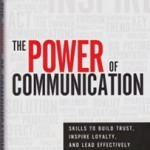
Click to buy Power of Communication
Comments:
Filed Under: Books
Posted by Elena del Valle on August 17, 2012
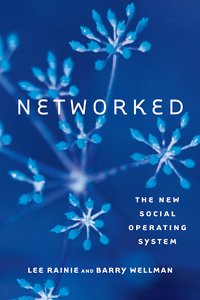
Networked book cover
Photo:The MIT Press
Lee Rainie, director, Pew Research Center Internet & American Life Project and Barry Wellman, S.D. Clark Professor of Sociology, University of Toronto believe digital communications via social media and smart phones, contrary to what others fear, are expanding learning opportunities, problem solving, decision making and personal relationships.
In Networked The New Social Operating System (The MIT Press, $29.95), published this year, they discuss the triple revolution they are convinced is transforming society in North America, sometimes for the better. The revolution the describe involves social networking, the internet and mobile digital devices.
At the beginning of the book, they illustrate what they see as the power of the revolution with the case of a couple who suffered from serious medical issues and thanks to their network of friends and acquaintances who knew them from professional and personal relationships asked for and received emotional and financial support. The authors believe people are now functioning within “networked individualism” that connects them to others in their circle of contacts in a novel way made possible by the triple revolution.
The 358-page hardcover book is divided into three sections: The Triple Revolution, How Networked Individualism Works, and How to Operate in a Networked World, Now and in the Future; and eleven chapters. In the final chapter, they discuss the future of networked individualism and their belief that social networks will play greater roles in people’s activities as well as the four areas they anticipate will be the source for issues relating to networked individualism in the future: internet, legislative, norms of social behavior within the network and technological commerce and related issues such as devices and apps.
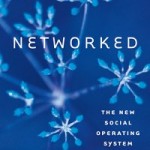
Click to buy Networked
Comments:
Filed Under: Books
Posted by Elena del Valle on August 3, 2012
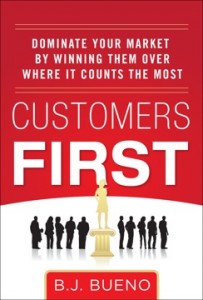
Customers First book cover
Photos: Newman Communications
What drives your customers? How do you create a brand that attracts loyal, profitable customers to your business? The correct answers to these questions could ensure the success of a company.
Bolivar J. “BJ” Bueno, founder and managing partner, The Cult Branding Company believes that most businesses struggle because they are not clear on the identity of their target customer; that they can’t rely on market research and focus groups for the answers because 90 percent of consumer behavior is unconscious; and that customers today are empowered, skeptical and educated consumers.
In Customers First: Dominate Your Market by Winning Them Over Where It Counts the Most (McGraw-Hill Professional, $26), his newly published 218-page hardcover book, he examines the strategic competitive advantage he believes comes from a complete, comprehensive understanding of a brand’s best customers. The book is divided into twelve chapters and four main parts, Introduction: Things Have Changed; Modeling Defined; Building Your Brand Model; and Deploying Your Model.

Bolivar J. Bueno, author, Customers First
Bueno says in the first chapter that there is no longer business as usual and that newcomers have to create a new normal. Customer awareness and loyalty, he explains in the next chapter, is what creates and expands a brand. Developing a great Brand Model, he says later in the book, requires time and adherence to that model. The author believes that effective predictions of consumer behavior helps make companies and their products or services dominant in the market.
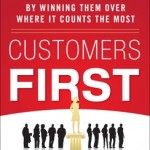
Click to buy Customers First
Comments:
Filed Under: Books
Posted by Elena del Valle on July 13, 2012

Cubans book cover
Photos: Facts About Cuban Exiles
Six women and twenty-five men contributed forty essays to Cubans: An Epic Journey (Reedy Press, $27.92), a 782-page softcover book with a 16-page photo section about their impressions of the South Florida Cuban exile experience from the 1950s until today published with the support of Facts About Cuban Exiles (FACE) with the sponsorship of John S. and James L. Knight, The Armando Codina Family, First Bank of Miami, Carlos Migoya, and Riteway Properties.
In the Introduction, the authors say that Cubans in the United States represent 3.5 percent of the Hispanic American population or approximately 1.8 million people. They explain that the largest concentration of Cubans (55 percent) lives in Greater Miami, Florida and describe the Miami community as having established a “parallel mainstream” where they “can sustain a refined culture – creating and preserving its own music, food, literature, theater, cinema, radio and television.”
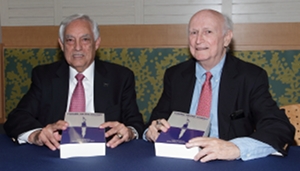
Sam Verdeja and Guillermo Martinez, editors, Cubans
The work was edited by Sam Verdeja, a magazine publisher, and Guillermo Martinez, a print and broadcast journalist. In addition to Verdeja and Martinez, Cesar Pizarro, a newspaper executive, Howard Kleinberg a newspaper editor, Louise O’ Brien, a business executive, Leonardo Rodriguez, a university professor and Francisco Rodriguez, a broadcast commentator participated in the project. Other contributors include Jose Cancela, Eloy Cepero, Raul Chao, Juan Clark, Olga Connor, Carlos Curbelo, Rogelio de la Torre, Sonia Frias, Jose Garrigo, Armando Gonzalez, Jose Irastorza, Federico Justiniani, Aida Levitan, Roly Martin, Rene Murai, Olga Nodarse, Marcos Antonio Ramos, Alejandro Rios, Raul Rodriguez, Rene Rodriguez, Silvia Unzueta, Enrique Viciana, Alberto Vilar, and Eduardo Zayas-Bazan.
The book is divided into 39 chapters in two major sections, The History in the first 16 chapters and The Exile Experience in the remaining chapters, as well as an Epilogue and five appendices. The second section of the book is subdivided into Business and Finance; Arts, Entertainment, and Religion; Media and Advertising; Professionals; and Political, Civic and Social Life.

Click to buy Cubans
Comments:
Filed Under: Books
Posted by Elena del Valle on June 29, 2012
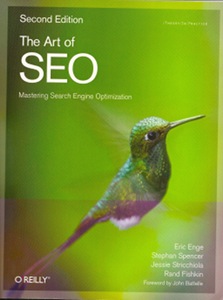
The Art of SEO book cover
Is search engine ranking an art or a science? What is the secret? Opinions vary and the answers are elusive at best. Yet, many continue to seek them because of the power they provide those who find even a fraction of success. In August 2011, people performed 158 billion online searches (comScore) and that same month 1.3 billion souls each relied on a search engine search.
Toward deciphering the ever changing secrets of search engine optimization (SEO) four experts combined years of knowledge and insights in search engine optimization to compile the second edition of The Art of SEO Mastering Search Engine Optimization (O’Reilly, $49.99), a 688-page softcover book published March of this year. Eric Enge, founder and chief executive officer, Stone Temple Consulting; Stephan Spencer, founder, Netconcepts; Jessie Stricchiola, founder, Alchemist Media, Inc.; and Rand Fishkin, chief executive officer and cofounder, SEOmoz, are the authors.
Although they identify anyone involved in the search engine optimization process at any level, especially web developers, development managers and marketers, as the target audience for the book judging by the size and complexity of some of the sections the book is not for the faint of heart or those who lack time to read. The authors promise to address updates on recent changes in search engine behavior like ranking methods requiring user engagement and social media; insights on insider SEO issues; the inner workings of search engines; the role of social media, user data, and links; how to track results and measure success; understanding how changes to a site may confuse search engines; building an SEO team; and future trends.
They point out that online searches, many on Google, reach 88 percent of people in the United States and billions internationally. They go on to outline that the dominant search engines in July 2011 were, in descending order, Google (65 percent), Yahoo (16 percent), Microsoft (14.4 percent), Ask (2.9 percent) and AOL (1.4 percent); and that in August 2011, searches were generally of one (25.8 percent) or two words (22.8 percent). Keeping abreast of search engine changes requires constant monitoring and adaptation and being an early adopter is essential, they point out. At the same time the long delay between adopting search engine optimization strategies and seeing results can be daunting; measuring results is important and can influence future budget decisions, they point out in a later chapter.
The tome is divided into 14 chapters with a very brief conclusion at the end of each: The Search Engines: Reflecting Consciousness and Connecting Commerce; Search Engine Basics; Determining Your SEO Objectives and Defining Your Site’s Audience; First Stages of SEO; Keyword Research; Developing an SEO-Friendly Website; Creating Link-Worthy Content and Link Marketing; How Social Media and User Data Play a Role in Research Results and Rankings; Optimizing for Vertical Search; Tracking Results and Measuring Success; Domain Changes, Post-SEO Redesigns, and Troubleshooting; SEO Research and Study; Build an In-House SEO Team, Outsource It, or Both? and An Evolving Art Form: The Future of SEO.
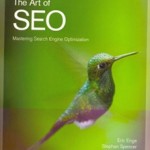
Click to buy The Art of SEO
Comments:
Filed Under: Books
Posted by Elena del Valle on June 15, 2012

#tweetsmart book cover
Photo: O’Reilly
As social media fever continues nationwide figuring out how to participate in social media channels may be rising on the list of priorities of marketing departments. Twitter, one of the fastest growing social media sites, has become increasingly popular in business circles. Although many believe Twitter is not to be used for self promotion users write about their products and services all the time.
For example, the Swedish Institute and Visit Sweden, the government tourist agency, on the advice of a Volontaire, an advertising company, has recruited a different volunteer to be interesting, Twitter-literate and post in English each week. They have been the voice of the nation of nine million; and ranged from a high school student in Trollhattan, a town in western Sweden, to a 60 year old. Following the Swedish lead similar projects in Ireland, New Zealand and the city of Leeds in England are sprouting. (see Swedes’ Twitter Voice: Anyone, Saying (Blush) Almost Anything in The New York Times).
“The first tendency of most marketing teams is to transplant old strategies onto this new technology, which can be fatal,” said Jesse McDougall, a programer and web strategist from Vermont. “Would-be marketers on Twitter can do more harm than good in a very short amount of time. This new approach to marketing—one based in discovery instead of interruption—is only going to grow in popularity in the coming years.”
In #tweetsmart 25 Twitter Projects to Help You Build Your Community (O’Reilly, $19.99), an 85-page softcover book published this year, McDougall, discusses Twitter as a platform to connect with interested, influential people. He explores, in 25 short chapters, ways to meet and connect with others to build a community in ways that “are strategic, measurable and fun.” He shares several contest and promotional ideas, and discusses hashtag use, doing market research by inviting Twitter followers to share input, adlib, Haiku, discussion groups, Tweet Bombs, and photo sharing.
McDougall, who has 12 years of experience as a web designer, programmer, and web strategist, is author of eight books about conducting business on the web.

Click to buy #tweetsmart
Comments:
Filed Under: Books
Posted by Elena del Valle on June 8, 2012
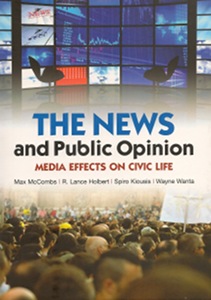
The News and Public Opinion book cover
Photos:R. Lance Holbert, Wayne Wanta, Spiro Kiousis
Four academics, Max McCombs, R. Lance Holbert, Spiro Kiousis* and Wayne Wanta, discuss the effects of news media (print, television and radio) on public opinion in The News and Public Opinion Media Effects on Civic Life (Polity Books, $22.95). In the 210-page softcover book published in 2011, they address the public’s attention to news media, effects of media exposure on the gathering of information and forming of attitudes and opinions, and how these elements affect public life or how the process affects public opinion.

R. Lance Holbert, co-author, The News and Public Opinion
The authors point out that some media are suffering financially. In relation to news they refer to how the television networks news programs have decreasing audience numbers which have led to a loss of profitability and power. Soft news programs are more profitable and the networks remain focused on making a profit; also, older men are the most likely to watch network news programs and a young demographic is not following in their footsteps, they say.

Wayne Wanta, co-author, The News and Public Opinion
Cable news networks like CNN and Fox News have a role as well. Fox News viewers, according to a study by Jonathan Morris, were not was well informed as the viewers of other television news programs, followed specific voting patters, held specific political views and had a political perspective distinct from viewers of other news networks.
Public trust of news media is very low and entertainment content within public affairs has become popular because “the present practice of journalism is so poor,” the authors say in the first chapter. Citizen involvement in journalism has been greatly enhanced, and continues through the internet; the audience of news media is decreasing and to reach them segmentation, including by ethnicity and language, has become increasingly necessary, the authors say. In the Audiences for News chapter, they indicate their belief that ethnic-based news media will continue to grow.

Spiro Kiousis, co-author, The News and Public Opinion
Education plays a role in learning from the media and people with high levels of education learn more and at a faster rate than their counterparts with low educational levels, according to the authors who discovered that newspaper readers learn more than television audiences. Gender also plays a role, they believe, with men favoring hard news and women favoring soft news. The authors also discuss media selectivity and the importance of form versus content.
*Elena del Valle and Spiro Kiousis serve on the University of Florida Public Relations Advisory Council.

Click to buy The News and Public Opinion
Comments:
Filed Under: Books
Posted by Elena del Valle on June 1, 2012

Running Lean book cover
Photos: Newman Communications
Ash Maurya, who has launched several start up companies, is convinced that most new products fail because those that launch them waste energy and resources on the wrong product. Figuring out what products to introduce into the market and how can be done by developing a plan, identifying the high risk parts of the plan and repeatedly testing the plan, he believes. In the second edition of Running Lean: Iterate from Plan A to A Plan That Works (O’Reilly, $24.99), published March 2012 as part of The Lean Series, he explains his thinking on the topic.
The book, written for entrepreneurs, business managers, senior executives, small business owners and anyone seeking to start a business project, presents a process he thinks optimizes the way to quickly outline and define good product ideas, maximizing the chances of success. Most product launches that succeed are ones that adjust their plans before they run out of resources, according to the book.
In the book, Maurya sets out to provide detailed tactics on ways to figure out what potential customers want, how to conduct a good customer interview, addressing issues such as finding the prospects and overcoming mental blocks when speaking to them. Talking to people is important, according to the author who thinks that running surveys and focus groups may seem more efficient than interviewing customers, but isn’t the best approach.

Ash Maurya, author, Running Lean
The 206-page hardcover book is divided into four parts: Roadmap, Document Your Plan A, Identify the Riskiest Parts of Your Plan, and Systematically Test Your Plan; and 15 chapters. Maurya, founder, Spark59, has worked closely with entrepreneurs, assisting them to test and fine tune their vision.
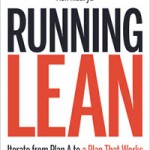
Click to buy Running Lean
Comments:
Filed Under: Books
Posted by Elena del Valle on May 25, 2012
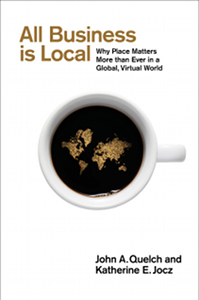
All Business Is Local book cover
Photos: Portfolio/Penguin, John Quelch and Katherine Jocz
I first heard about a chain of healthy fast food restaurants through a colleague across the country. Because of her high endorsement I tried the one nearest to me and liked it. Over time the food and service declined noticeably. I, and many others who used to stand in line there, stopped going. It doesn’t matter how popular the chain remains at the national level I no longer patronize it because the local restaurant is not to my liking. This might be what experts refer to when they say location matters.
Businesses, regardless of their size, must be local and global in order to thrive, according to John Quelch, dean, China Europe International Business School (CEIBS), and Katherine Jocz, a marketing consultant. In their book, All Business Is Local: Why Place Matters More Than Ever in a Global, Virtual World (Portfolio/Penguin Group USA, $25.95), published this year, John Quelch and Jocz explain their reasoning.

Katherine Jocz, coauthor, All Business Is Local
Too often companies focus on a global market and neglect local aspects, they say. The authors believe people shop at the stores that make sense to them regardless of the global efforts or reputation of the company that owns them or the brand. Location matters now more than ever, according to them. Place, they say in the Introduction, is “one of the most reliable bases for targeting and positioning decisions.” They stress that the more connected we become worldwide the more we will want to focus on local rather than global.

John Quelch, coauthor, All Business Is Local
Global brands like Real Madrid, Starbucks and McDonald’s are often local favorites because of their ties to the communities where they are located; adapting selections and menus to local tastes, buying locally, and employing locally are some of the strategies successful companies rely on, the authors say in the book.
The 248-page book is divided into one Introduction and five chapters: Managing Psychological Place, Managing Physical Place, Managing Virtual Place, Marketing Geographic Place, and Marketing Locally and Globally. Quelch was formerly associate dean of the Harvard Business School and dean of the London Business School. Jocz was formerly a research associate of the Harvard Business School and a director of networks and relationships at Marketspace.

Click to buy All Business Is Local
Comments:
Filed Under: Books






































